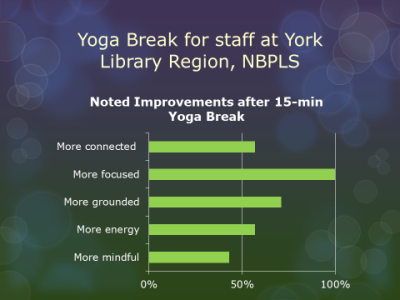Welcome to the first post about kinesthetic library programming! I have been teaching yoga in school and public libraries since 2008. This is a great post to read if you are thinking about doing yoga programs at your own library. You probably have a lot of questions, so let’s get started.

So what, exactly, is yoga?
There are a lot of people doing it and wearing the comfy pants, but what are its roots? The word yoga means "union," to yoke, to join together. Yoga is the joining of the mind and body to bring the whole person into harmony. It is an eight-limbed system designed to lead a person towards enlightenment, of which hatha yoga (or the poses we all know) is only one component. The physical poses are designed to calm and focus the mind while preparing the body for long periods of contemplation and meditation. It has been around for an estimated 5,000 years, but many of the poses we recognize, like sun salutations, have only been added over the last few centuries. Hatha yoga isn’t a religion or a cult, so there are no worries about indoctrinating any of your patrons or students.
Who can do yoga?
My first answer to that question is EVERYBODY. If you’ve got a body and you can move some of it, you can do yoga. I’ve seen yoga done with people in wheelchairs, babies, the elderly, pregnant women, big muscly gym guys with no flexibility, high schoolers and people with developmental or cognitive disabilities. Most poses can be modified to fit a person’s needs or limitations. And everyone can benefit from learning how to relax, being more mindful and feeling more grounded. With our increasingly sedentary lifestyles and rising obesity rates, anything we can do to get people moving is important.
Aren’t there a bunch of different types of yoga?
There have been an explosion of different types of yoga in the west in the last 20 years as everyone scrambles to trademark their own personal brand of yoga and profit from its current trendiness. Any yoga taught in libraries needs to follow the basic tenets of hatha yoga. There are libraries offering laughter yoga, chair yoga, storybook yoga, mom and baby yoga, yoga for relaxation and yoga for seniors. The best approach is to talk to your patrons and find out what would be most valuable in your community. Like any other library program — know your audience! If you’d like to know more about the different branches of hatha yoga there is a great book available, called "Pick Your Yoga Practice," by Meagan McCrary. There's a review of the book on my website, Yoga in the Library.
Isn’t meditation and mindfulness part of yoga?
Stop reading. Breathe. Right now you are thinking about breathing. In two seconds you are going to start thinking about something else. Then you say to yourself, “Oh, I’m thinking.” And then you come back to your breath. Meditation isn’t so much a clearing of the mind, or a deep state of peace, but rather this flow back and forth, this push and pull between your mind being present and it wandering off into the future or the past. It is the act of awareness itself that is meditation. Mindfulness is a technique of bringing this awareness into our daily lives. So when you are at the grocery store and you catch yourself being anxious while standing in line, you can observe the feelings of anxiety in your body and you’ll notice that the feeling eventually passes, because no emotional state is permanent. That’s what emotions are — they are energy in motion. Sometimes you’ll notice when you are really concentrating on something, especially if it is something you enjoy, you’ll be in a kind of flow state where your mind is naturally clear and focused on the task at hand, like my son Benji here navigating this tightrope. This is mindfulness, this is present moment awareness.
Why offer yoga?
As libraries move away from being places strictly for storing and retrieving written materials and into being important cultural and community hubs, it only makes sense to offer programs that will appeal to a wider audience of existing patrons and attract a demographic who might not be regularly visiting our spaces. Offering free wellness sessions to people who might not otherwise be able to afford them also aligns with our mandate to provide outreach, access and support to everyone in our community.
What about yoga for my staff?

As you can see by the results of an anonymous survey I administered to staff at the York Library Region in Fredericton, NB, yoga and meditation programs really benefit behind the scenes as well — and even in some unexpected ways. One person commented that our yoga class “reinforced that 'break' doesn't have to mean stationary rest.” Another strong benefit is the closeness that develops between coworkers when they participate in a wellness program together. Someone responded, “This practice has helped me develop a bond with coworkers that isn’t solely derived from the work that we do together.” That’s exciting!
Don’t you need training in order to teach yoga programs?
My first answer is YES. If you are going to provide full-on yoga programs you need to either have someone on staff who is a certified yoga teacher with at least 200 hours of training and or you need to hire a teacher or recruit a volunteer from your community. If they are providing classes to patrons with special needs where many of the poses need to be modified, they also should have some background in anatomy and how to do adjustments.
That said, do I think you need to be a fully certified yoga teacher to add a few fun poses to a children’s storytime or to add a little meditation break into your workday? No, absolutely not. As long as you have at least six months experience practicing yoga and meditation yourself, I can’t see why you can’t share that experience in a fun and safe way with others. Another alternative would be to bring in an experienced yoga instructor to teach your staff the basics so they feel more confident delivering yoga as part of their existing programs.
What about the legal issues? What if someone gets hurt?
Most libraries have insurance to cover incidents that happen accidentally within the four walls of the library, but that would need to be verified with a lawyer, your board of directors and any other stakeholders. I like to play it safe and get patrons, or parents if you are teaching children, to sign a waiver releasing the teacher and the library from any responsibility should the patron or child experience an injury while participating in the program. I also like to remind all students to only do what feels good for their body and not to worry what is happening on their neighbor’s mat. A good yoga teacher will reinforce that we need to be gentle, patient and persistent with ourselves and not push ourselves beyond 80 percent of our capabilities.
Lastly, should we charge for classes? Should we provide mats and props?
My goal is always to make programs as accessible (i.e.: FREE) as possible. If you have a volunteer or staff member who can teach for free, you are set. If not, does your budget allow for you to pay an outside teacher? They will either charge per hour or per person. Their rate may be anywhere from $25-150+ for a class. I am fortunate that the Fredericton Public Library, where I currently teach, received a grant to purchase yoga mats for their programs that patrons can borrow for free. See what funding is available in your area. Look under the key words of "health and wellness," "mental health," "children's physical fitness programs," "senior funding," "low-income," "outreach" and "nonprofit," as a start. As a last resort you could ask for a donation. I call that "karma yoga" and put out a bowl and hope people who can afford it will throw some change into it when they come to class, but don't expect to fund the whole program on it.
I hope you have enjoyed this Q & A post about running yoga programs in libraries. For more information and resources, please visit www.yogainthelibrary.com.



